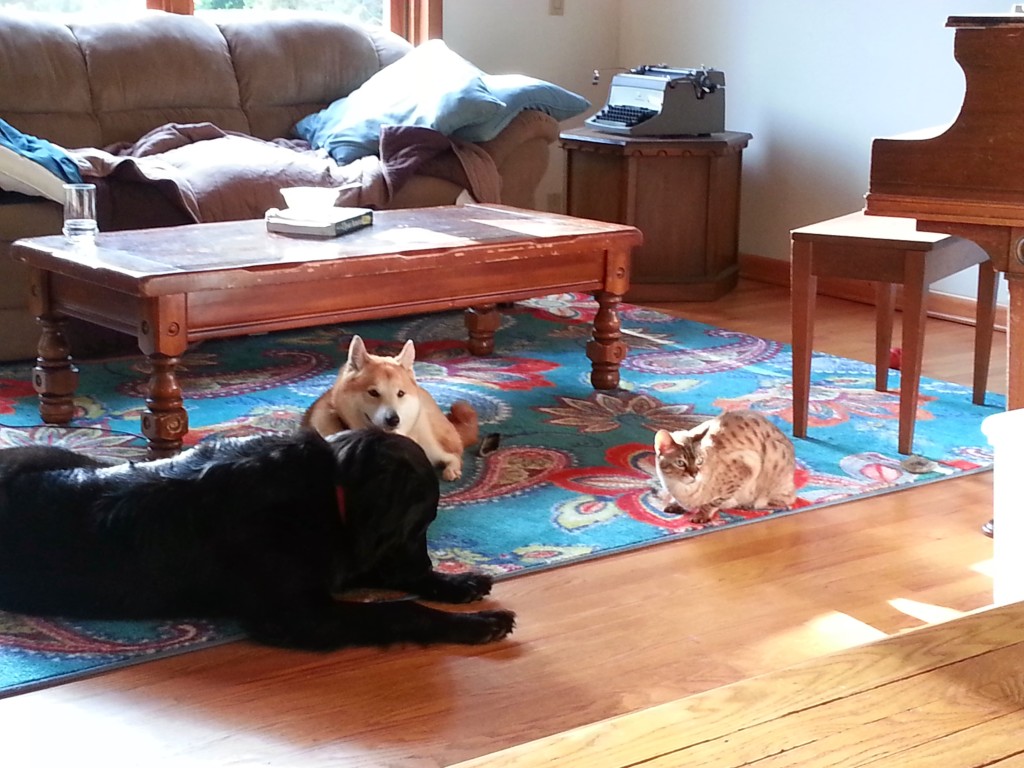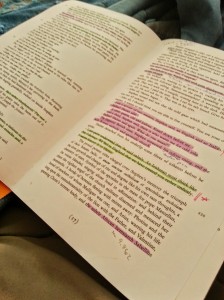Okay, so if you are reading through Ulysses as I am posting these, this is probably the first section that you really run the risk of getting hung up on. The language and style here are a bit more complicated than in previous sections, and if you aren’t accustomed to reading things in stream of consciousness, it can be disconcerting, to say nothing of the subject matter being outside most people’s familiarity. Don’t panic though—once you get into it, this section is great, and it’s not as difficult as you may be thinking right now.
Basically what happens in this section, and I don’t want to over-simplify, is that Stephen is killing time before he meets Buck, so he walks along the beach at Sandymount Strand and thinks about philosophy. He remembers his time studying in Paris and his father recalling him to Dublin because of his mother’s illness. He writes a poem. He urinates.

Why do these few things seem intimidating? Moreso than the previous chapters, Joyce has here used a style called stream of consciousness, which can be disconcerting to the uninitiated reader. Stream of consciousness is a technique used for providing readers with a window to the character’s interior world; however, it is not simply as straightforward as having a character essentially “say” what they are thinking. Contrast the two following paragraphs:
One summer afternoon Mrs Oedipa Maas came home from a Tupperware party whose hostess had put perhaps too much kirsch in the fondue to find that she, Oedipa, had been named executor, or she supposed executrix, of the estate of one Pierce Inverarity, a California real estate mogul who had once lost two million dollars in his spare time but still had assets numerous and tangled enough to make the job of sorting it all out more than honorary. Oedipa stood in the living room, stared at by the greenish dead eye of the TV tube, spoke the name of God, tried to feel as drunk as possible. But this did not work. She thought of a Lotel room in Mazatlán whose door had just been slammed, it seemed forever, waking up two hundred birds down in the lobby; a sunrise over the library slope at Cornell University that nobody out on it had seen because the slope faces west; a dry, disconsolate tune from the fourth movement of the Bartók Concerto for Orchestra; a whitewashed bust of Jay Gould that Pierce kept over the bed on a shelf so narrow for it she’d always had the hovering fear it would someday topple on them. Was that how he’d died, she wondered, among dreams, crushed by the only ikon in the house? That only made her laugh, out loud and helpless: You’re so sick, Oedipa, she told herself, or the room, which knew. (Pynchon, 1965, 1–2)
His gaze brooded on his broadtoed boots, a buck’s castoffs, nebeneinander. He counted the creases of rucked leather wherein another’s foot had nested warm. The foot that beat the ground in tripudium, foot I dislove. But you were delighted when Esther Osvalt’s shoe went on you: girl I knew in Paris. Tiens, quel petit pied! Staunch friend, a brother’s soul: Wilde’s love that dare not speak its name. His arm: Cranly’s arm. He now will leave me. And the blame? As I am. As I am. All or not at all. (3.446–52)
In both paragraphs, we see the character’s environment and hear her/his thoughts. But Oedipa’s thoughts are to a point (the death of Pierce Inverarity and her history with him), while Stephen’s thoughts wander from his shoes[1] to a woman he knew in Paris to a literary allusion boyhood friend (Cranly). Oedipa’s thoughts are also marked out with certain guideposts, words like “supposed,” “thought,” “wondered,” while Stephen’s thoughts arise more organically from the paragraph.
Joyce’s version is more accurate, in my (limited?) experience as a thought-having human being. Most people don’t think in straight lines and in sentences. At the same time, Joyce’s version is more difficult and risky. He has to trust that his audience will understand the shift from what Stephen is doing (looking at his boots) to what he is thinking without needing little signposts to mark the way. He doesn’t even typographically set the thoughts off from the narration through the use of italics. This is—in my estimation, at least—gutsy. As a writer, one always worries about the reader understanding what one is trying to do. (I say “one” because as far as I can tell, this is a universal problem.) I admire the panache here as Joyce just throws the chapter out there, like a challenge to his readers. It’s also risky to write an entire chapter with so little movement. The plot, if one can claim Ulysses has a plot, is not advanced here in any significant way. Primarily this is a full chapter of character development; more than that, as Stephen cools his heels, we are also killing time. It is risky to slow down the story like that—when you lose your momentum, you risk boring your audience and losing them as well. But the fascinating use of language here keeps us reading. (Or keeps me reading, at least.)
So how as a reader do you deal with the mélange of thoughts, memories, and even bits of external narration found here? I have tried two different strategies. The first is to get a copy of the Gifford and look everything up. Gifford is quite thorough in this episode—though it is only a bit more than 500 lines, he offers twenty-two pages of notes. Nearly every line seems to be noted. On the other hand, you can also just forge ahead and let the text wash over you. Although if you read what I just said about the Gifford you may be shaking your head, I think this is a tenable strategy. The stuff in the notes is largely interesting but not essential to understanding the text—sure, it is nice to get a translation of the few French phrases, or to know that “lawn Tennyson” (3.492) is a play on the game of lawn tennis and Alfred, Lord Tennyson, but these things are not essential to understanding what is going on, they only enrich the experience. I do encourage you as a reader just to dive in; you may not get every reference, but you will get the gist of what is going on, and some of the references will become more clear as you go on in the book.[2]
I have one other thing I want to discuss, and that is Stephen’s poem. I will quote it here:
He comes, pale vampire, through the storm his eyes, his bat sails bloodying the sea, mouth to her mouth’s kiss. (3.397–8)
Joyce actually wrote two books of poetry[3]. I haven’t made a thorough investigation of them, but I don’t recall being blown away by the ones I did read.[4] This poem in particular is a derivative work—Gifford refers to it as “a souped-up . . . version of the last stanza of ‘My Grief on the Sea,’ a poem translated from the Irish by Douglas Hyde” (1988, 62). It is one of the marvelous Joycean ironies of this book that while Stephen-who-is-Joyce is lying on the beach writing these kind of wretched poems, Joyce himself is writing this amazing chapter that is actually quite poetic in much of its language and that is also such a break from what came before in so many ways.[6]
This has been a shorter essay than some of the others, I think. Not to suggest that this episode is less good, but I have less to say about it because I can either talk about these general things or give a sort of line-by-line discussion of what I’m enjoying,[7] which could be a bit tedious. Next time though, we get to Mr Leopold Bloom, and I am excited to talk about him, so make sure you tune in—same blog time, same blog channel.
Notes
[1] Could we take a moment to admire the shoe-related puns here? Stephen is wearing shoes given to him by a friend (I assume Buck Mulligan, owing to remarks in ep. 1 on other clothes he has given Stephen, plus the phrase “a buck’s castoffs,” but the text seems to be nonspecific), and could potentially be addressing his remarks (the “you”) to either the friend or the shoes. When he says, “Staunch friend, a brother’s soul,” he could be referring to Mulligan, or to the shoes themselves, which also have a soul (sole).
[2] Your goal in general should be to make it as far as episode 17 (Ithica). That episode will explain a lot.
[3] Chamber Music and Pomes Penyeach.
[4] Wikipedia notes that many of his poems are still in print in anthologies today, and that some of the poems in Chamber Music were widely regarded as being technical masterpieces. It also notes that in 1909, Joyce wrote to Nora Barnacle[5] that “When I wrote [Chamber Music] I was a lonely boy, walking about by myself at night and thinking that one day a girl would love me” (Source). That is such a lovely sentiment I take back any of the mean things I said.
[5] The woman he eloped with after going on a first date with her on June 16, 1904, which PERHAPS NOT COINCIDENTALLY is the day Ulysses is set on. They actually didn’t get married until 1931, despite having two kids in 1905 and 1907 respectively.
[6] Except possibly Tristram Shandy? Hm.
[7] I cannot believe I wrote over a thousand words and didn’t find a way to work in a brief discussion about the beach being full of clammy sand (“His blued feet out of turnedup trousers slapped the clammy sands . . .” [3.370–1]). It’s clammy because it’s coldish and dampish, and it’s clammy because it’s a beach and there are clams in it. YES.
References
Gifford, Don, with Robert J. Seidman. Ulysses Annotated: Notes for James Joyce’s Ulysses. 2nd ed., rev. and exp. Berkeley: University of California Press, 1988.
Pynchon, Thomas. The Crying of Lot 49. New York: Bantam, 1965.



